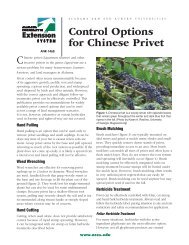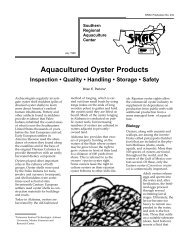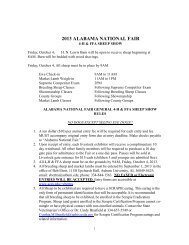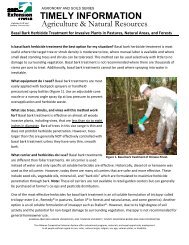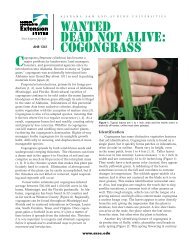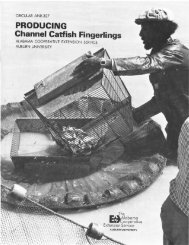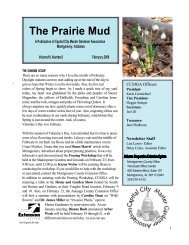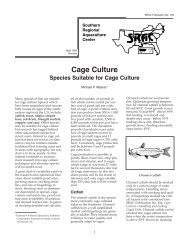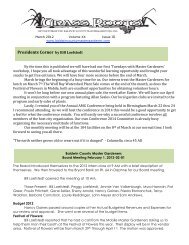Subterrranean Termites - Termitas Subterráneas
Subterrranean Termites - Termitas Subterráneas
Subterrranean Termites - Termitas Subterráneas
You also want an ePaper? Increase the reach of your titles
YUMPU automatically turns print PDFs into web optimized ePapers that Google loves.
Control<br />
Control measures include reducing the<br />
potential infestation, preventing termite entry,<br />
and applying chemicals for remedial treatment.<br />
Inspection<br />
Inspect thoroughly to determine if there is an<br />
infestation, damage, conditions that could invite<br />
a termite attack, or the need for remedial control<br />
measures. The tools and equipment needed for<br />
an inspection include a flashlight, ice pick or<br />
sharp-pointed screwdriver, ladder, and protective<br />
clothing.<br />
Outdoors<br />
Check the foundation of the house, garage and<br />
other buildings for shelter tubes coming from<br />
the soil. Look closely around porches, connecting<br />
patios, sidewalks, areas near kitchens or<br />
bathrooms and hard-to-see places. Check<br />
for termite infestation or wood decay along window<br />
and door frames and where utility services<br />
enter the house. Also look behind shrubbery or<br />
plants near walls. Pay special attention to areas<br />
where earth and wood meet such as fences, stair<br />
carriages or trellises. Open and check any<br />
exterior electrical meter or fuse box set into<br />
the wall, a common point of infestation.<br />
Indoors<br />
Carefully check all doors, window facings,<br />
baseboards and hardwood flooring. Discoloration<br />
or stains on walls or ceilings may mean that<br />
water is leaking and can decay wood and aid<br />
termite infestation. It is very important to<br />
inspect where plumbing or utility pipes enter<br />
the foundation or flooring. Also examine the<br />
attic for shelter tubes, water leakage, wood rot<br />
or wood damage.<br />
herramienta puntiaguda, tal como un picahielos,<br />
para encontrar las termitas o su daño.<br />
Control<br />
Las medidas de control incluyen: reducir la<br />
posibilidad de infestación, prevenir la entrada<br />
de termitas y remediar con aplicación de<br />
tratamientos químicos.<br />
Inspección<br />
Revise bien para ver si hay una infestación,<br />
daño, condiciones que inviten una invasión de<br />
termitas o si se necesitan tomar medidas de<br />
control. Las herramientas y el equipo necesario<br />
para una inspección incluyen una linterna<br />
eléctrica, picahielos o desarmador puntiagudo,<br />
una escalera y ropa protectora.<br />
Afuera de la casa<br />
Revise el cimiento de la casa, garaje y otros<br />
edificios para ver si hay túneles de refugio que<br />
vienen desde el suelo. Mire bien alrededor de<br />
portales, patios, banquetas, áreas cerca de<br />
cocinas o cuartos de baño y lugares retirados.<br />
Revise los marcos de puertas y ventanas y donde<br />
entran a la casa los servicios de utilidad para<br />
saber si hay una infestación de termitas o<br />
deterioro de madera. También mire detrás de<br />
las plantas cerca de las paredes. Ponga atención<br />
especial a áreas donde tierra y madera se<br />
juntan, tal como cercas, escalones o espalderas.<br />
Abra y revise cualquier caja de fusibles o<br />
medidor colocado en la pared, un lugar común<br />
de infestación.<br />
Adentro de la casa<br />
Revise cuidadosamente todas las puertas,<br />
ventanas, rodapíes y pisos de madera.<br />
Descoloramiento o manchas en las paredes o los<br />
cielos pueden indicar que agua ésta goteando y



